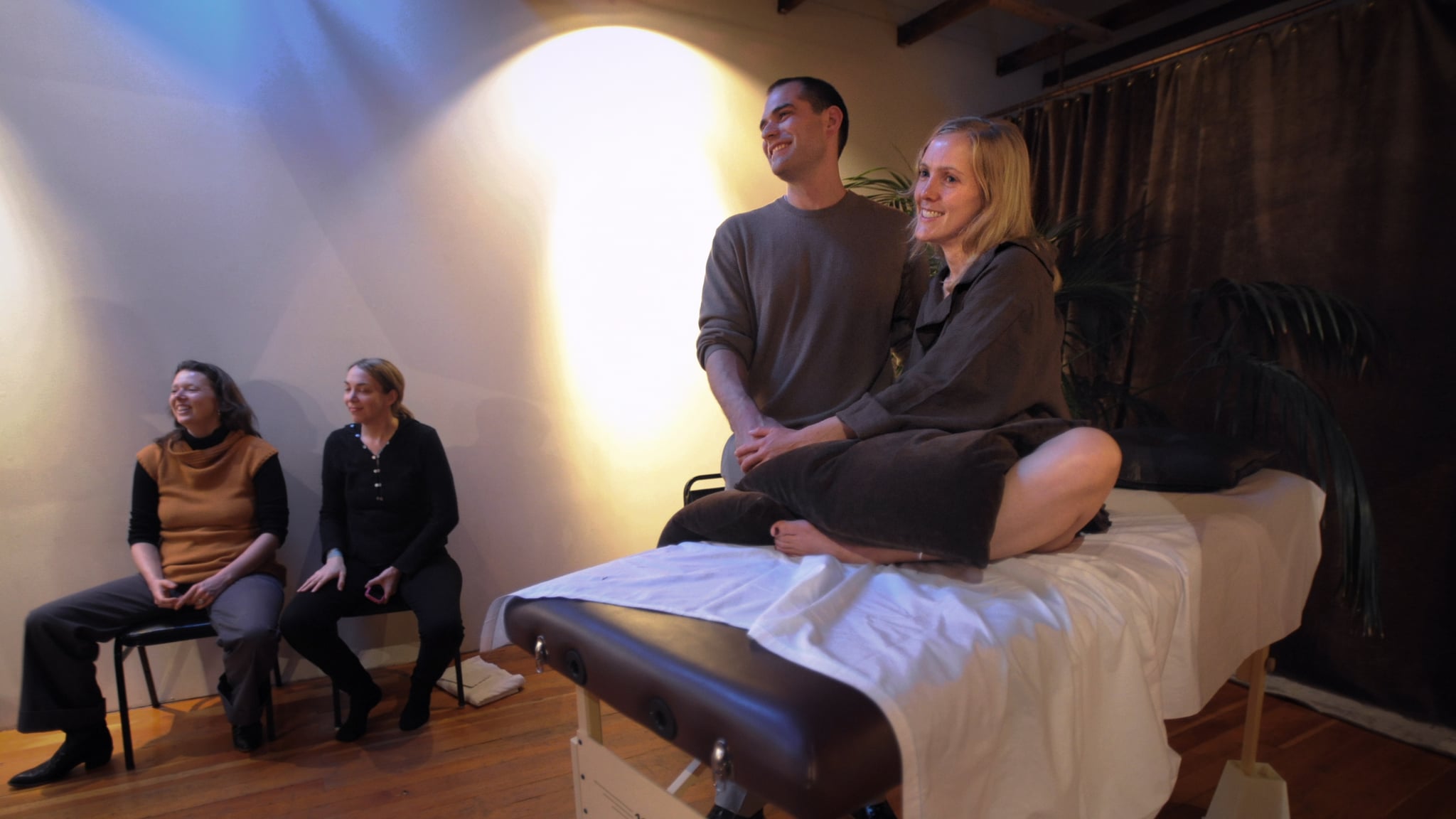Orgasmic Meditation: What to Know and How to Do It
What Is Orgasmic Meditation?

For many people, orgasmic meditation (OM) is a beautiful practice that mixes sexuality and mindfulness to help them achieve maximum pleasure. But for those involved in the controversial wellness company called OneTaste, OM has a whole other meaning.
In the newly released Netflix documentary "Orgasmic Inc.," which dropped Nov. 7, the exposé details OneTaste's history of alleged sexual assault, predatory sales practices, and "cult-like activities." And unfortunately, one of the practices they regularly seemed to abuse was orgasmic meditation (OM).
For those unfamiliar, OneTaste is an organisation that "provides people with teaching and trainings into living a desire-based life, rooted in a felt-sense of connection," according to their website. They further describe themselves as being "on the verge of great change, desire, power, and women's liberation," and claimed to offer orgasm training services for women looking to heal from sexual trauma. While this sounds great in theory, OneTaste is known for doing far more harm than good.
Despite OneTaste giving OM a bad rap, when OM is practiced in a consensual, mindful, and pleasurable way, it can be a very wonderful and healing practice. Let's explore what orgasmic meditation really is, the potential benefits, and how to try it for yourself, if interested.
What Is Orgasmic Meditation?
Orgasmic meditation (OM) is a practice done between two partners that's designed to "increase pleasure capacity and sensation awareness" for people with vulvas, says somatic sex educator Kiana Reeves, chief content officer at plant-based sexual wellness brand, Foria. The practice involves a "very specific and structured" set-up where the receiver lays comfortably on their back with their legs open for a designated amount of time. The giving partner then strokes the upper left quadrant of their partner's clitoris with one finger, and as they touch, they adjust as needed (for stroke, speed, pressure, etc.) as instructed by their partner.
According to OneTaste, they coined the term "orgasmic meditation" themselves. However, the practice likely originated long before OneTaste was founded in 2005. After all, many sexual meditative practices, including sexual kung fu, were influenced by Eastern practices. And, if you look at the origins of meditation in general, it's been traced all the way back to 5000 BCE — so it's hard to say how far back orgasmic meditation really goes.
What Are the Benefits of Orgasmic Mediation?
According to Buddhist sex therapist Cheryl Fraser, PhD, practicing OM can:
- increase emotional and spiritual connection with your partner
- improve sexual responsivity and pleasure for people with pelvic pain, sexual trauma, low arousal, etc.
- reduce stress and anxiety
- bring a new type of lovemaking into your erotic repertoire which combines the mind, heart, and body
- increase your ability to experience powerful, mind-blowing, lasting pleasure
Reeves also adds that specifically being on the receiving end of OM can help you focus on the present, increase your capacity for more pleasure and stimulation over time, improve your ability to receive (and reduce the pressure to give), and allow you to become more comfortable with your genitals.
After all, "When someone's looking at your vulva and paying attention to every micro movement and response in your body, you naturally build a capacity to be seen," Reeves says — which can be a big hurdle for some people during sexual interactions.
On the giving side of things, OM can help you learn to track pleasure cues in your partner's body, making for an improved connection between the two of you. It can also help you develop a better understanding of your partner's mental space and what they need emotionally to experience pleasure.
How to Practice Orgasmic Meditation
One commonly practiced technique, according to Reeves, is as followed:
- Organise a comfortable space (or nest) with pillows and blankets where you can lay on your back and rest with your legs folded open.
- Agree that this is a non-reciprocated sexual practice, so acknowledge that once the 15 minutes is over, nothing else will happen — nor are there any other expectations.
- Get comfy, wash your hands, sit down together, and breathe before starting. Make eye contact and feel the care you have for each other.
- Set a timer for 15 minutes.
- Guide your partner to the most sensitive part of your clitoral area. As they touch for 15 minutes, ask for the adjustments you need from them in terms of stroke, speed, pressure, etc.
- Stop when the timer ends. Take a few breaths together.
- Repeat weekly or a few times a week – however often feels beneficial.
This is similar to the method used by OneTaste, only it focuses on centreing consent, pleasure, and privacy — as true OM should, Reeves says.
However, there are other ways to practice OM, too. In fact, Good Vibrations's staff sexologist Carol Queen, PhD tells POPSUGAR that practicing OM can look however you want it to look. "There is no one way you should experience your body or your sexuality," Dr. Queen says. In other words, they suggest you practice clitoral touching in whatever way that feels best for you — no matter if it's with or without a partner or longer or shorter than 15 minutes.
Fraser, for example, coaches couples to practice mindful sexuality and conscious orgasm instead of a step-by-step process of OM. "The key is to slow down, take your time, focus deeply, and not race to the finish line." Basically, your goal is to de-prioritise orgasm as your goal, and "just" enjoy the sensations.
If this approach sounds like something you want to try while giving, here is what Fraser suggests:
- Set a timer for 45 minutes. Ask your partner to lay comfortably. Begin to touch and explore their body very slowly. Touch, tease, and tantalize them without touching their usual erogenous zones (clitoris, vulva, penis, scrotum, perineum, butt, anus, or nipples). Instead, explore other sensations on the whole body.
- When approaching the point of orgasm, look into your partner's eyes. Breathe slowly, focus on the touch, the sensations, and the pleasure, and be in the present moment.
- Take turns giving each other a soft, sensual, sexy genital massage. Ask your lover to focus their mind only on the touch of your fingers or tongue. Bring them close to orgasm then back away.
Fraser reminds couples that it's not exactly the touch itself that matters or turns you on — it's literally your mind. "That's why I tell the couples in my program over and over that great sex is all in your head."
What's the Difference Between Orgasmic Meditation and Normal Stimulation?
There are a few key differences here. For one, during orgasmic meditation, the focus is not on the orgasm, but more so the experience. While this should be the case for all of the pleasurable experiences you engage in, with orgasmic meditation specifically, the receiver should focus more on the sensations and how stimulating everything feels rather than the end-goal being an orgasm.
Another difference is that, during orgasmic meditation, the attention is focussed solely on the receiver. After the giver is done pleasuring the receiver for the allotted amount, the session is over. This is so the receiver can focus solely on their own pleasure and sensations instead of worrying about taking too long or when it should be their turn to "return the favour." That said, if you and your partner decide you'd like to switch roles and not end the session completely after the allocated time, that's completely OK too.
Lastly, and perhaps the biggest difference, is that orgasmic meditation includes significantly more breath work and meditative practices. Both the giver and receiver should actively check in with each other in order to sync their breathing and connect beyond the physical level. You can do this by sitting face-to-face before starting activities and inhaling together for three seconds, then exhaling together for three seconds. You can continue to do this as the session continues.
All that to say, when done with consent and in a pleasure-first environment, orgasmic meditation can be a beautiful practice to try with a trusted partner.








